Easter egg
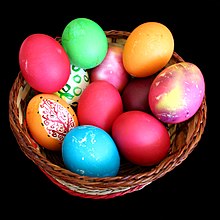
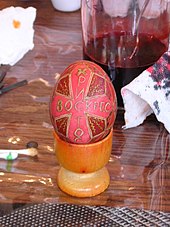
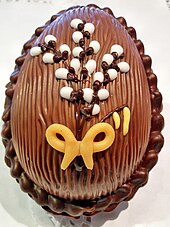
Easter eggs,also calledPaschal eggs,[1]areeggsthat aredecoratedfor the Christian holiday ofEaster,which celebrates theresurrection of Jesus.As such, Easter eggs are commonly used during the season ofEastertide(Easter season). The oldest tradition, which continues to be used inCentralandEastern Europe,is to dye and paint chicken eggs.
Although eggs, in general, were a traditional symbol of fertility and rebirth,[2]inChristianity,for the celebration of Eastertide, Easter eggs symbolize theempty tombofJesus,from which Jesus wasresurrected.[3][4][5]In addition, one ancient tradition was the staining of Easter eggs with the colour red "in memory of theblood of Christ,shed as at that time of his crucifixion. "[3][6]
This custom of the Easter egg, according to many sources, can be traced toearly ChristiansofMesopotamia,and from there it spread into Eastern Europe and Siberia through the Orthodox Churches, and later into Europe through the Catholic and Protestant Churches.[6][7][8][9]Additionally, the widespread usage of Easter eggs, according to mediaevalist scholars, is due to the prohibition of eggs duringLentafter which, on Easter, they are blessed for the occasion.[10][11]
A modern custom in some places is to substitute chocolate eggs wrapped in colouredfoil,hand-carved wooden eggs, or plastic eggs filled withconfectionerysuch aschocolate.

History
[edit]The practice ofdecorating eggshellsis quite ancient,[12]with decorated, engravedostrich eggsfound in Africa which are 60,000 years old.[13]In thepre-dynastic periodofEgyptand the early cultures ofMesopotamiaandCrete,eggs were associated with death and rebirth, as well as with kingship, with decorated ostrich eggs, and representations of ostrich eggs in gold and silver, were commonly placed in graves of the ancient Sumerians and Egyptians as early as 5,000 years ago.[14]These cultural relationships may have influenced early Christian and Islamic cultures in those areas, as well as through mercantile, religious, and political links from those areas around the Mediterranean.[15]
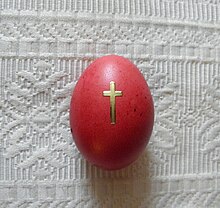
Eggs inChristianitycarry aTrinitariansymbolism as shell, yolk, and albumen are three parts of one egg.[16]According to many sources, the Christian custom of Easter eggs started among theearly ChristiansofMesopotamia,who stained them with red colouring "in memory of the blood of Christ, shed at Hiscrucifixion".[7][17][6][8][9]TheChristian Churchofficially adopted the custom, regarding the eggs as a symbol of theresurrection of Jesus,with theRoman Ritual,the first edition of which was published in 1610 but which has texts of much older date, containing among the Easter Blessings of Food, one for eggs, along with those for lamb, bread, and new produce.[8][9]
Lord, let the grace of your blessing + come upon these eggs, that they be healthful food for your faithful who eat them in thanksgiving for the resurrection of our Lord Jesus Christ, who lives and reigns with you forever and ever.
Sociology professor Kenneth Thompson discusses the spread of the Easter egg throughoutChristendom,writing that "use of eggs at Easter seems to have come from Persia into the Greek Christian Churches of Mesopotamia, thence to Russia and Siberia through the medium of Orthodox Christianity. From the Greek Church the custom was adopted by either the Roman Catholics or the Protestants and then spread through Europe."[7]Both Thompson, as well as British orientalistThomas Hydestate that in addition to dyeing the eggs red, the early Christians of Mesopotamia also stained Easter eggs green and yellow.[6][7]
Peter Gainsford maintains that the association between eggs and Easter most likely arose in western Europe during the Middle Ages as a result of the fact that Catholic Christians were prohibited from eating eggs during Lent, but were allowed to eat them when Easter arrived.[10][11]
Influential 19th centuryfolkloristandphilologistJacob Grimmspeculates, in the second volume of hisDeutsche Mythologie,that thefolk customof Easter eggs among the continental Germanic peoples may have stemmed from springtime festivities of aGermanic goddessknown in Old English asĒostre(namesake of modern EnglishEaster) and possibly known in Old High German as *Ostara(and thus namesake of Modern GermanOstern'Easter'). However, despite Grimm's speculation, there is no evidence to connect eggs with a speculative deity named Ostara.[11]The use of eggs as favors or treats at Easter originated when they were prohibited during Lent.[10][11]A common practice in England in the medieval period was for children to go door-to-door begging for eggs on the Saturday before Lent began. People handed out eggs as special treats for children prior to theirfast.[11]
Although one of the Christian traditions are to use dyed or painted chicken eggs, a modern custom is to substitute chocolate eggs, or plastic eggs filled withcandysuch asjelly beans;as many people give up sweets as theirLenten sacrifice,individuals enjoy them at Easter after having abstained from them during the preceding forty days ofLent.[18]These eggs can be hidden for children to find on Easter morning, which may be left by theEaster Bunny.They may also be put in abasketfilled with real or artificial straw to resemble abird's nest.
Traditions and customs
[edit]

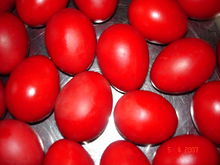
Lenten tradition
[edit]The Easter egg tradition may also have merged into the celebration of the end of the privations ofLent.Traditionally, eggs are among the foods forbiddenfastdays, including all of Lent, an observance which continues among theEastern Christian Churchesbut has fallen into disuse inWestern Christianity.
Historically, it has been traditional to use up all of the household's eggs before Lent began.
This established the tradition ofPancake Daybeing celebrated onShrove Tuesday.This day, the Tuesday beforeAsh Wednesdaywhen Lent begins, is also known asMardi Gras,a French phrase which translates as "Fat Tuesday" to mark the last consumption of eggs and dairy before Lent begins.
In the Orthodox Church,Great Lentbegins onClean Monday,rather than Wednesday, so the household's dairy products would be used up in the preceding week, calledCheesefare Week.
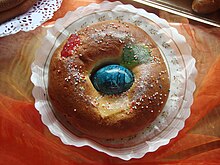
During Lent, since chickens would not stop producing eggs during this time, a larger than usual store might be available at the end of the fast. This surplus, if any, had to be eaten quickly to prevent spoiling. Then, with the coming of Easter, the eating of eggs resumes. Some families cook a special meatloaf with eggs in it to be eaten with the Easter dinner.
To avoid waste, it was common for families tohard boilorpickleeggs that their chickens produced during lent, and for this reason theSpanish dishhornazo(traditionally eaten on and around Easter) contains hard-boiled eggs as a primary ingredient. InSpainit is common for godparents to give aEaster monato their godchildren during Easter period. InHungary,eggs are used sliced in potato casseroles around the Easter period.
Symbolism and related customs
[edit]Some Christians symbolically link the cracking open of Easter eggs with theempty tombof Jesus.[19]
In the Orthodox churches, Easter eggs areblessedby the priest at the end of thePaschal Vigil(which is equivalent toHoly Saturday), and distributed to the faithful. The egg is seen by followers ofChristianityas a symbol ofresurrection:while being dormant it contains a new life sealed within it.[3][4]
Similarly, in theRoman Catholic ChurchinPoland,the so-calledświęconka,i.e. blessing of decorative baskets with a sampling of Easter eggs and other symbolic foods, is one of the most enduring and beloved Polish traditions on Holy Saturday.
DuringPaschaltide,in some traditions the Pascal greeting with the Easter egg is even extended to the deceased. On either the second Monday or Tuesday of Pascha, after amemorial servicepeople bring blessed eggs to the cemetery and bring the joyouspaschal greeting,"Christ has risen", to their beloved departed (seeRadonitza).
InGreece,women traditionally dye the eggs with onion skins and vinegar on Thursday (also the day ofCommunion). These ceremonial eggs are known as kokkina avga. They also baketsourekifor the Easter Sunday feast.[20]Red Easter eggs are sometimes served along the centerline of tsoureki (braided loaf of bread).[21][22]
InEgypt,it is a tradition to decorate boiled eggs duringSham el-Nessimholiday, which falls every year after theEastern ChristianEaster.
Coincidentally, every Passover, Jews place a hard-boiled egg on the Passover ceremonial plate, and the celebrants also eat hard-boiled eggs dipped in salt water as part of the ceremony.
Colouring
[edit]

The dyeing of Easter eggs in different colours is commonplace, with colour being achieved through boiling the egg in natural substances (such as,onionpeel (brown colour),oakoralderbark orwalnutnutshell (black),beetjuice (pink) etc.), or usingartificial colourings.
A greater variety of colour was often provided by tying on the onion skin with different coloured woollenyarn.In the North of England these are called pace-eggs or paste-eggs, from a dialectal form of Middle Englishpasche.King Edward I's household accounts in 1290 list an item of 'one shilling and sixpence for the decoration and distribution of 450 Pace-eggs!',[23]which were to be coloured or gilded and given to members of the royal household.[24]Traditionally in England, eggs were wrapped inonionskins and boiled to make their shells look like mottled gold, or wrapped in flowers and leaves first in order to leave a pattern, which parallels a custom practised in traditionalScandinavianculture.[25]Eggs could also be drawn on with a wax candle before staining, often with a person's name and date on the egg.[24]Pace Eggs were generally eaten for breakfast onEaster Sundaybreakfast. Alternatively, they could be kept as decorations, used in egg-jarping (egg tapping) games, or given toPace Eggers.In more recent centuries in England, eggs have been stained with coffee grains[24]or simply boiled and painted in their shells.[26]
In the Orthodox and Eastern Catholic Churches, Easter eggs are dyed red to represent theblood of Christ,with further symbolism being found in the hard shell of the egg symbolizing the sealedTomb of Christ—the cracking of which symbolized his resurrection from the dead. The tradition of red easter eggs was used by theRussian Orthodox Church.[27]The tradition to dyeing the easter eggs in an Onion tone exists in the cultures ofArmenia,Bulgaria,Georgia,Lithuania,Ukraine,Belarus,Russia,Czechia,Romania,Serbia,Slovakia,Slovenia,andIsrael.[28]The colour is made by boiling onion peel in water.[29][30]
Patterning
[edit]When boiling them with onion skins, leaves can be attached prior to dyeing to create leaf patterns. The leaves are attached to the eggs before they are dyed with a transparent cloth to wrap the eggs with like inexpensive muslin or nylon stockings, leaving patterns once the leaves are removed after the dyeing process.[31][32]These eggs are part ofEaster customin many areas and often accompany other traditionalEaster foods.Passoverhaminadosare prepared with similar methods.
Pysanky[33]are Ukrainian Easter eggs, decorated using a wax-resist (batik) method. The word comes from the verbpysaty,"to write", as the designs are not painted on, but written withbeeswax.Lithuanians create intricately detailed margučiai using a hot wax application and dipping method, and also by dipping the eggs first and then etching designs into the shells.[34]
Decorating eggs for Easter using wax resistant batik is a popular method in some other eastern European countries.
Use of Easter eggs in decorations
[edit]In someMediterraneancountries, especially inLebanon,chicken eggs are boiled and decorated by dye and/or painting and used as decoration[35]around the house. Then, onEaster Day,young kids would duel with them saying "Christ is resurrected, Indeed, He is", breaking and eating them. This also happens inGeorgia,Bulgaria,Cyprus,Greece,North Macedonia,Romania,Russia, Serbia and Ukraine. In Easter Sunday friends and family hit each other's egg with their own. The one whose egg does not break is believed to be in for good luck in the future.
In Germany, eggs decorate trees and bushes asEaster egg trees,and in several areas public wells asOsterbrunnen.
There used to be a custom inUkraine,during Easter celebrations to havekrashankyon a table in a bowl with wheatgrass. The number of thekrashankyequalled the number of departed family members.[36]
-
Ukrainian Easter eggs
-
Easter eggs fromSorbs
-
Easter eggs fromLithuania
-
Perforated egg fromGermany,Sleeping Beauty
-
Norwegian Easter eggs
-
Easter eggs fromGreece
-
Perforated eggs
-
Easter eggs fromFrance
-
American Easter egg from theWhite HouseWashington, D.C.
-
Pace eggs boiled with onion skins and leaf patterns.
-
Easter eggs decorated with straw
-
Easter egg fromPoland
-
Washi eggfrom Japan
Easter egg games
[edit]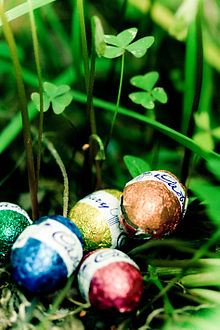
Egg hunts
[edit]Anegg huntis a game in whichdecorated eggs,which may be hard-boiled chicken eggs,chocolateeggs, or artificial eggs containingcandies,are hidden for children to find. The eggs often vary in size, and may be hidden both indoors and outdoors.[37]When the hunt is over, prizes may be given for the largest number of eggs collected, or for the largest or the smallest egg.[37]
Some Central European nations (Czechs,Slovaks,etc.) have a tradition of men gathering eggs from women in return for whipping them with aneaster whipandsplashing them with water.The ritual is traditionally believed to preserve the women's health and beauty.
Cascarones,a Latin American tradition now shared by many US States with high Hispanic demographics, are emptied and dried chicken eggs stuffed with confetti and sealed with a piece of tissue paper. The eggs are hidden in a similar tradition to the American Easter egg hunt and when found the children (and adults) break them over each other's heads.
In order to enable children to take part in egg hunts despite visual impairment, eggs have been created that emit various clicks, beeps, noises, or music so that visually impaired children can easily hunt for Easter eggs.[38]
Egg rolling
[edit]Egg rollingis also a traditional Easter Egg game played with eggs at Easter. In the United Kingdom, Germany, and other countries children traditionally rolled eggs down hillsides at Easter.[39]This tradition was taken to theNew Worldby European settlers,[39][40]and continues to this day each Easter with anEaster egg rollon theWhite Houselawn.Rutherford B. Hayesstarted the tradition of the Easter Egg Roll at the White House.[41]The Easter Monday Egg Roll was normally held at the United States Capitol, however, by the mid-1870s, Congress passed a law forbidding the Capitol's grounds to be used for the activity due to the toll it was taking on the landscape.[41]The law was enforced in 1877, but the rain that year canceled all outdoor activities.[41]In 1878, Hayes was approached by many young Easter Egg rollers who asked for the event to be held at the White House.[41]He invited any children who wanted to roll eggs to come to the White House in order to do so. The tradition still occurs every year on the South Lawn of the White House. Now, there are many other games and activities that take place such as "Egg Picking" and "Egg Ball".[41]Different nations have different versions of the Easter Egg roll game.
Egg tapping
[edit]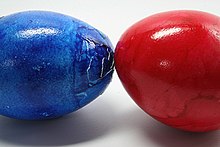
In theNorth of England,during Eastertide, a traditional game is played where hard boiledpace eggsare distributed and each player hits the other player's egg with their own. This is known as "egg tapping","egg dumping ", or" egg jarping ". The winner is the holder of the last intact egg. The annual egg jarping world championship is held every year over Easter inPeterlee,Durham.[42]
It is also practiced in Italy (where it is calledscuccetta), Poland, Bulgaria, Hungary, Croatia, Latvia, Lithuania, Lebanon, North Macedonia, Romania, Serbia, Slovenia (where it is calledturčanjeortrkanje), Ukraine, Russia, and other countries. In parts of Austria, Bavaria and German-speaking Switzerland it is calledOstereiertitschenorEierpecken.In parts of Europe it is also calledepper,presumably from the German nameOpfer,meaning "offering" and in Greece it is known astsougrisma.In SouthLouisiana,this practice is called pocking eggs[43][44]and is slightly different. TheLouisiana Creoleshold that the winner eats the eggs of the losers in each round.
In the Greek Orthodox tradition, red eggs are also cracked together when people exchange Easter greetings.
Egg dance
[edit]Egg danceis a traditional Easter game in which eggs are laid on the ground or floor and the goal is to dance among them without damaging any eggs[45]which originated in Germany.
Pace egg plays
[edit]ThePace Egg playsare traditional village plays, with a rebirth theme. The drama takes the form of a combat between the hero and villain, in which the hero is killed and brought back to life. The plays take place in England during Easter.

Variants
[edit]Chocolate
[edit]Chocolate eggs first appeared at the court ofLouis XIVin Versailles and in 1725 the widow Giambone inTurinstarted producing chocolate eggs by filling empty chicken egg shells with molten chocolate.[46]In 1873,J.S. Fry & Sonsproduced the first hollow chocolate egg using egg moulds.[47]Manufacturing their first Easter egg in 1875,Cadburycreated the modern chocolate Easter egg after developing a pure cocoa butter that could be moulded into smooth shapes.[48]
In Western cultures, the giving of chocolate eggs is now commonplace, with 80 million Easter eggs sold in the UK alone. Formerly, the containers Easter eggs were sold in contained large amounts of plastic, although in the United Kingdom this has gradually been replaced with recyclable paper and cardboard.[49]
In Brazil, Argentina, Chile Uruguay and Paraguay,[50]hollow chocolate eggs known asOvos de PáscoaorHuevos de Páscua(Easter eggs) are popular and are commonly sold around Easter in supermarkets.[51][52]Variations of this dessert containing fillings such as pistachio cream, hazelnut cream,furrundu[53]ordoce de leite,are known asOvos de Páscoa de colher(Spoon Easter eggs) orOvos de colher(Spoon eggs).[54][55][56][57]
-
Chocolate Easter egg bunny
-
Easter egg with candy
-
Gladysas a ChocolateEaster Bunnywith Easter eggs
-
BrazilianOvos de Páscoafor sale in a supermarket
Marzipan eggs
[edit]In the Indian state of Goa, theGoan Catholic version of marzipanis used to make easter eggs. In the Philippines, mazapán de pili (Spanish for "pili marzipan" ) is made from pili nuts.
-
Marzipan easter eggs
Artificial eggs
[edit]Thejewelled Easter eggsmade by the Fabergé firm for the two last RussianTsarsare regarded as masterpieces of decorative arts. Most of these creations themselves contained hidden surprises such as clock-work birds, or miniature ships.
In Bulgaria, Poland, Romania, Russia, Ukraine, and otherCentral Europeancountries'folk traditions,Easter eggs are carved from wood and hand-painted, and making artificial eggs out ofporcelainfor ladies is common.[58]: 45
Easter eggs are frequently depicted in sculpture, including a 8-metre (27 ft) sculpture of a pysanka standing inVegreville,Alberta.
-
Giant easter egg,Bariloche,Argentina
-
Giant pysanka fromVegreville,Alberta,Canada
-
Giant easter egg orpisanicainZagreb,Croatia
-
Easter egg sculpture inGogolin,Poland
-
Giant easter egg inSuceava,Romania
Legends
[edit]
Christian traditions
[edit]While the origin of Easter eggs can be explained in the symbolic terms described above, among followers ofEastern Christianitythelegendsays thatMary Magdalenewas bringing cooked eggs to share with the other women at the tomb of Jesus, and the eggs in her basket miraculously turned bright red when she saw the risen Christ.[59]
A different, but not necessarily conflicting legend concerns Mary Magdalene's efforts to spread theGospel.According to this tradition, after theAscension of Jesus,Mary went to the Emperor of Rome and greeted him with "Christ has risen," whereupon he pointed to an egg on his table and stated, "Christ has no more risen than that egg is red." After making this statement it is said the egg immediately turned blood red.[60][61]
Red Easter eggs, known askokkina avga(κόκκινα αυγά) in Greece andkrashankiinUkraine,are anEastertradition and a distinct type of Easter egg prepared by variousOrthodox Christianpeoples.[62][63][64][65][66]The red eggs are part ofEaster customin many areas and often accompany other traditionalEaster foods.Passoverhaminadosare prepared with similar methods. Dark red eggs are a tradition in Greece and represent the blood ofChristshed on the cross.[67]The practice dates to the early Christian church inMesopotamia.[8][9] In Greece, superstitions of the past included the custom of placing the first-dyed red egg at the home'siconostasis(place where icons are displayed) to ward off evil. The heads and backs of small lambs were also marked with the red dye to protect them.
Parallels in other faiths
[edit]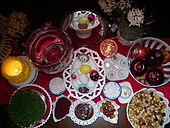
The egg is widely used as a symbol of the start of new life, just as new life emerges from an egg when the chick hatches out.[2]
Painted eggs are used at the Iranian spring holidays, theNowruzthat marks the first day ofspringorEquinox,and the beginning of the year in thePersian calendar.It is celebrated on the day of the astronomicalNorthward equinox,which usually occurs on March 21 or the previous/following day depending on where it is observed. The painted eggs symbolize fertility and are displayed on the Nowruz table, calledHaft-Seentogether with various other symbolic objects. There are sometimes one egg for each member of the family. The ancientZoroastrianspainted eggs for Nowruz, their New Year celebration, which falls on theSpring equinox.The tradition continues among Persians ofIslamic,Zoroastrian,and other faiths today.[68]The Nowruz tradition has existed for at least 2,500 years. The sculptures on the walls ofPersepolisshow people carrying eggs for Nowruz to the king.[citation needed]
TheNeopaganholiday ofOstaraoccurs at roughly the same time as Easter. While it is often claimed that the use of painted eggs is an ancient, pre-Christian component of the celebration of Ostara, there are no historical accounts that ancient celebrations included this practice, apart from theOld High German lullabywhich is believed by most to be a modern fabrication. Rather, the use of painted eggs has been adopted under the assumption that it might be a pre-Christian survival. In fact, modern scholarship has been unable to trace any association between eggs and a supposed goddess named Ostara before the 19th century, when early folklorists began to speculate about the possibility.[69]
There are good grounds for the association betweenhares(later termedEaster bunnies) andbird eggs,through folklore confusion between hares' forms (where they raise their young) andplovers' nests.[70]
InJudaism,a hard-boiled egg is an element of thePassover Seder,representing festival sacrifice. The children's game of hunting for theafikomen(a half-piece of matzo) has similarities to the Easter egg hunt tradition, by which the child who finds the hidden matzah will be awarded a prize. In other homes, the children hide the afikoman and a parent must look for it; when the parents give up, the children demand a prize for revealing its location.
See also
[edit]References
[edit]- ^"The Legend of Paschal Eggs (Holy Cross Antiochian Orthodox Church)"(PDF).Archived(PDF)from the original on 2015-04-12.Retrieved2013-11-26.
- ^abDavid Leeming (2005).The Oxford Companion to World Mythology.Oxford University Press.p.111.Retrieved10 March2013.
For many, Easter is synonymous with fertility symbols such as the Easter Rabbit, Easter Eggs, and the Easter lily.
- ^abcAnne Jordan (5 April 2000).Christianity.Nelson Thornes.ISBN9780748753208.Archivedfrom the original on 9 April 2023.Retrieved7 April2012.
Easter eggs are used as a Christian symbol to represent the empty tomb. The outside of the egg looks dead but inside there is new life, which is going to break out. The Easter egg is a reminder that Jesus will rise from His tomb and bring new life. Orthodox Christians dye boiled eggs red to make red Easter eggs that represent the blood of Christ shed for the sins of the world.
- ^abThe Guardian, Volume 29.H. Harbaugh. 1878.Archivedfrom the original on 9 April 2023.Retrieved7 April2012.
Just so, on that first Easter morning, Jesus came to life and walked out of the tomb, and left it, as it were, an empty shell. Just so, too, when the Christian dies, the body is left in the grave, an empty shell, but the soul takes wings and flies away to be with God. Thus you see that though an egg seems to be as dead as a stone, yet it really has life in it; and also it is like Christ's dead body, which was raised to life again. This is the reason we use eggs on Easter. (In days past some used to color the eggs red, so as to show the kind of death by which Christ died,-abloodydeath.)
- ^Gordon Geddes, Jane Griffiths (22 January 2002).Christian belief and practice.Heinemann.ISBN9780435306915.Archivedfrom the original on 9 April 2023.Retrieved7 April2012.
Red eggs are given to Orthodox Christians after the Easter Liturgy. They crack their eggs against each other's. The cracking of the eggs symbolizes a wish to break away from the bonds of sin and misery and enter the new life issuing from Christ's resurrection.
- ^abcdHenry Ellis(1877).Popular antiquities of Great Britain.p.90.Retrieved26 March2016.
Hyde,in his Oriental Sports (1694), tells us one with eggs among the Christians of Mesopotamia on Easter Day and forty days afterwards, during which time their children buy themselves as many eggs as they can, stain them with a red colour in memory of the blood of Christ, shed as at that time of his crucifixion. Some tinge them with green and yellow.
- ^abcdThompson, Kenneth (21 August 2013).Culture & Progress: Early Sociology of Culture, Volume 8.Routledge.p. 138.ISBN9781136479403.
In Mesopotamia children secured during the 40-day period following Easter day as many eggs as possible and dyed them red, "in memory of the blood of Christ shed at that time of his Crucifixion" --a rationalization. Dyed eggs were sold in the market, green and yellow being favorite colors. The use of eggs at Easter seems to have come from Persia into the Greek Christian Churches of Mesopotamia, thence to Russia and Siberia through the medium of Orthodox Christianity. From the Greek Church the custom was adopted by either the Roman Catholics or the Protestants and then spread through Europe.
- ^abcdDonahoe's Magazine, Volume 5.T.B. Noonan. 1881.Archivedfrom the original on 9 April 2023.Retrieved7 April2012.
The early Christians of Mesopotamia had the custom of dyeing and decorating eggs at Easter. They were stained red, in memory of the blood of Christ, shed at His crucifixion. The Church adopted the custom, and regarded the eggs as the emblem of the resurrection, as is evinced by the benediction of Pope Paul V., about 1610, which reads thus: "Bless, O Lord! we beseech thee, this thy creature of eggs, that it may become a wholesome sustenance to thy faithful servants, eating it in thankfulness to thee on account of the resurrection of the Lord." Thus the custom has come down from ages lost in antiquity.)
- ^abcdVicki K. Black (1 July 2004).Welcome to the Church Year: An Introduction to the Seasons of the Episcopal Church.Church Publishing, Inc.ISBN9780819219664.Archivedfrom the original on 9 April 2023.Retrieved17 October2020.
The Christians of this region in Mesopotamia were probably the first to connect the decorating of eggs with the feast of the resurrection of Christ, and by the Middle Ages this practice was so widespread that in some places Easter Day was called Egg Sunday. In parts of Europe, the eggs were dyed red and were then cracked together when people exchanged Easter greetings. Many congregations today continue to have Easter egg hunts for the children after services on Easter Day.
- ^abcGainsford, Peter (26 March 2018)."Easter and paganism. Part 2".Kiwi Hellenist.Archivedfrom the original on 28 November 2019.Retrieved28 November2019.
- ^abcdeD'Costa, Krystal."Beyond Ishtar: The Tradition of Eggs at Easter".Scientific American.Archivedfrom the original on 28 March 2018.Retrieved28 March2018.
- ^Neil R. Grobman (1981).Wycinanki and pysanky: forms of religious and ethnic folk art from the Delaware Valley.University of Pittsburgh.Archivedfrom the original on 9 April 2023.Retrieved18 April2014.
During the spring cycle of festivals, ancient pre-Christian peoples used decorated eggs to welcome the sun and to help ensure the fertility of the fields, river...
- ^"Egg Cetera #6: Hunting for the world's oldest decorated eggs | University of Cambridge".Cam.ac.uk. 2012-04-10.Archivedfrom the original on 2013-09-28.Retrieved2013-03-31.
- ^Treasures from Royal Tombs of Ur By Richard L. Zettler, Lee Horne, Donald P. Hansen, Holly Pittman 1998 pgs 70-72
- ^Green, Nile (2006). "Ostrich Eggs and Peacock feathers: Sacred Objects as Cultural Exchange between Christianity and Islam".Al-Masaq: Journal of the Medieval Mediterranean.18(1).
This article uses the wide dispersal of ostrich eggs and peacock feathers among the different cultural contexts of the Mediterranean – and beyond into the Indian Ocean world – to explore the nature and limits of cultural inheritance and exchange between Christianity and Islam. These avian materials previously possessed symbolic meaning and material value as early as the pre-dynastic period in Egypt, as well as amid the early cultures of Mesopotamia and Crete. The main early cultural associations of the eggs and feathers were with death/resurrection and kingship respectively, a symbolism that was passed on into early Christian and Muslim usage. Mercantile, religious and political links across the premodern Mediterranean meant that these items found parallel employment all around the Mediterranean littoral, and beyond it, in Arabia, South Asia and Africa.
- ^Murray, Michael J.; Rea, Michael C. (20 March 2008).An Introduction to the Philosophy of Religion.Cambridge University Press.p. 68.ISBN978-1-139-46965-4.
- ^Williams, Victoria (21 November 2016).Celebrating Life Customs around the World.ABC-CLIO.p. 2.ISBN9781440836596.
The history of the Easter egg can be traced back to the time of the advent of Christianity in Mesopotamia (around the first to the third century), when people use to stain eggs red as a reminder of the blood spilled by Christ during the Crucifixion. In time, the Christian church in general adopted this custom with the eggs considered to be a symbol of both Christ's death and Resurrection. Moreover, in the earliest days of Christianity Easter eggs were considered symbolic of the tomb in which Jesus's corpse was laid after the Crucifixion for eggs, as a near universal symbol of fertility and life, were like Jesus's tomb, something from which new life came forth.
- ^Shoda, Richard W. (2014).Saint Alphonsus: Capuchins, Closures, and Continuity (1956-2011).Dorrance Publishing. p. 128.ISBN978-1-4349-2948-8.
- ^Allen, Emily (25 December 2016)."When is Easter 2016? What are the dates for Good Friday, Easter Sunday and Easter Monday".The Daily Telegraph.Archived fromthe originalon 24 February 2016.Retrieved26 February2016.
Eggs illustrate new life, just as Jesus began his new life on East Sunday after the miracle of his resurrection. When eggs are cracked open they are said to symbolise an empty tomb.
- ^Wagstaff, Natalie."Kalo Paska - Happy Easter".Archived fromthe originalon 2014-12-26.Retrieved2014-12-10.
- ^Walker, Judy (7 April 2014)."Today's Recipe from Our Files: Greek Easter bread, Tsoueki".NOLA.com.Archivedfrom the original on 18 December 2022.Retrieved18 December2022.
- ^Red and Butter, Martha Stewart magazine
- ^Castelow, Ellen (23 May 2015)."Pace Egging".Historic UK.Archivedfrom the original on 2021-01-23.Retrieved2021-02-16.
- ^abcLewis, Stephen (11 April 2020)."The history behind the Easter pace eggs at York's Castle Museum".York Press.Archivedfrom the original on 2021-04-04.Retrieved2021-02-16.
- ^Hall, Stephanie (2017-04-06)."The Ancient Art of Decorating Eggs | Folklife Today".Library of Congress Blogs.Archivedfrom the original on 2021-03-21.Retrieved2021-02-16.
- ^Ravenscroft, John."Pace Egging: A Lancashire Tradition".TimeTravel-Britain.com.Archivedfrom the original on 2021-02-11.Retrieved2021-02-16.
- ^Kubilius, Kerry (June 3, 2019)."In Russia the Color Red Represents More Than You Know".TripSavvy.Archivedfrom the original on 2019-03-29.Retrieved2019-03-19.
- ^Morante, Coco (May 30, 2019)."How To Dye Easter Eggs with Onion Skins".Kitchn.Archivedfrom the original on 2019-03-29.Retrieved2019-03-19.
- ^Sorokina, Anna (2018-03-29)."How to paint Easter eggs with onion, coffee and beets (PHOTOS)".Russia Beyond.Archivedfrom the original on 2019-03-29.Retrieved2019-03-19.
- ^Forman, Daria (2015-03-28)."The Easter Traditions in Belarus".Eastbook.eu.Archived fromthe originalon 2019-03-29.Retrieved2019-03-19.
- ^Royer, Blake (April 30, 2023)."How to Dye Easter eggs naturally without a box onion skins beets cabbage".Serious Eats.Archivedfrom the original on 2014-12-14.
- ^"Natural Easter Eggs 3 Ways!".Natasha's Kitchen. 20 March 2013.Archivedfrom the original on 24 October 2014.
- ^Culture – Pysanky,Ukrainian International DirectoryArchived2021-09-20 at theWayback Machine
- ^"Velykos Traditions".Filadelfijos Lietuvių Namai.2014-01-03. Archived fromthe originalon 2023-05-30.Retrieved2023-05-30.
- ^"Osterdeko - fünf Ideen rund um das Osterei | Anton Doll Holzmanufaktur".www.antondoll.de.Archivedfrom the original on 2020-08-13.Retrieved2020-08-18.
- ^Yakovenko, Svitlana 2017, “The Magical Dyed Egg – Krashanka” inTraditional Velykden: Ukrainian Easter RecipesArchived2017-03-26 at theWayback Machine,Sova Books, Sydney
- ^abA. Munsey Pu Frank a. Munsey Publishers (March 2005).The Puritan April to September 1900.Kessinger Publishing. p. 119.ISBN978-1-4191-7421-6.[permanent dead link]
- ^Tillery, Carolyn (2008-03-15)."Annual Dallas Easter egg hunt for blind children scheduled for Thursday".The Dallas Morning News.Archived fromthe originalon 2008-03-19.Retrieved2008-03-27.
- ^ab"Easter Eggs - Egg Rolling".Inventors.about.com. 2012-04-09. Archived fromthe originalon 13 July 2012.Retrieved2012-09-24.
- ^"Easter Eggs: their origins, tradition and symbolism".Wyrdology.com. Archived fromthe originalon 2008-05-17.Retrieved2008-03-15.
- ^abcde"History of the White House Easter Egg Roll".Archivedfrom the original on 2022-11-20.Retrieved2022-11-20.
- ^Hutchinson, Pamela (8 April 2012)."Egg jarping: when hard-boiled eggs come to blows".The Guardian.Archivedfrom the original on 28 October 2019.Retrieved14 June2019.
- ^"Pocking eggs or la toquette".Creolecajun.blogspot.com. 17 March 2008.Archivedfrom the original on 2011-07-16.Retrieved2008-03-20.
- ^"If Your Eggs Are Cracked, Please Step Down: Easter Egg Knocking in Marksville".Archivedfrom the original on 2017-03-16.Retrieved2008-03-20.
- ^Venetia Newall (1971).An egg at Easter: a folklore study.Routledge & K. Paul. p.344.ISBN978-0-7100-6845-3.
- ^Caramia, G; Degl'Innocenti, D; Mozzon, M; Pacetti, D; Frega, NG (2012)."[The role of eggs in the diet: nutraceutical and epigenetic aspects]"(PDF).La Pediatria Medica e Chirurgica: Medical and Surgical Pediatrics.34(2): 53–64.doi:10.4081/pmc.2012.1.PMID22730629.
- ^"How the hollow chocolate Easter egg was produced".BBC News.2023-04-09.Retrieved2023-04-09.
- ^"Amazing archive images show how Cadbury cracked Easter egg market".Birmingham Mail.Archivedfrom the original on 9 August 2020.Retrieved21 May2019.
- ^"The End of Egg-cessive Easter Waste??".Waste connect.Archivedfrom the original on 16 April 2014.Retrieved15 April2014.
- ^"¿Por qué en otros países se comen huevos de chocolate en Pascua?".20 March 2016.
- ^"Ovos de Páscoa: que países têm essa tradição e como eles comemoram a data"[Easter eggs: which countries have this tradition and how they celebrate the date].Folha de S.Paulo(in Brazilian Portuguese). 2023-03-31.Retrieved2024-03-29.
- ^"Saiba como surgiu a tradição de pendurar ovos de páscoa em lojas"[Find out how the tradition of hanging Easter eggs in stores came about].IstoÉ Dinheiro(in Brazilian Portuguese). 2023-04-06.Retrieved2024-03-29.
- ^"Confeiteira faz ovos de Páscoa com recheios de doces típicos da culinária cuiabana"[Confectioner makes Easter eggs filled with typical sweets from Cuiabá cuisine].G1(in Brazilian Portuguese). 6 April 2020.Retrieved29 May2024.
- ^"Bacio di Latte cria ovo de pistacchio, exclusivo para a Páscoa"[Bacio di Latte creates exclusive pistachio egg for Easter].O Globo(in Brazilian Portuguese). 2024-02-29.Retrieved2024-03-29.
- ^"Sodiê Doces lança oito sabores de ovo de colher para a Páscoa"[Sodiê Doces launches eight flavors of spoon egg for Easter].Campinas.com.br(in Brazilian Portuguese).Retrieved2024-03-29.
- ^"Ovo de Páscoa é mesmo 'melhor' que barras, e receita 'de colher' só existe no Brasil"[Easter egg is even 'better' than bars, and 'spoon' recipe only exists in Brazil].Folha de S.Paulo(in Brazilian Portuguese). 2023-03-30.Retrieved2024-03-29.
- ^Rolim, Laura (2024-02-26)."Ovo de chocolate tradicional ou de colher? Veja como o comércio se prepara para as vendas de Páscoa"[Traditional chocolate egg or spoon? See how retailers are preparing for Easter sales].abc+(in Brazilian Portuguese).Retrieved2024-03-29.
- ^Anderson, F.L.M., 1864, Seven Months' Residence in Russian Poland in 1868, London:Macmillan and Co.
- ^"Traditions of Great Lent and Holy Week".Melkite Greek Catholic Eparchy of Newton. Archived fromthe originalon 2012-01-22.Retrieved2012-09-24.
- ^Terry Tempest Williams (September 18, 2001).Leap.Random House Digital, Inc.ISBN9780679752578.Archivedfrom the original on 9 April 2023.Retrieved7 April2012.
After the Ascension, she travelled to Rome and was granted entrance to the court of Tiberius Caesar. At dinner, she told Caesar that Jesus had risen from the dead. He did not understand. To explain, Mary Magdalene picked up an egg from the table. Caesar responded by saying that a human being could no more rise from the dead than the egg in her hand turn red. The egg turned red.
- ^Newall, Venetia (1971).An egg at Easter: a folklore study.Routledge & K. Paul. p. 216.ISBN9780710068453.
In Russian tradition an egg, which she held in her hand, turned red, as a proof of the Resurrection.
- ^Red eggs at Pascha EasterArchived2018-04-05 at theWayback Machinehe Most Useful KNOWLEDGE for the Orthodox Russian-American Young People,” compiled by the Very Rev’d Peter G. Kohanik, 1932-1934.
- ^"Easter EGG".stdgocunion.org.Archived fromthe originalon 21 December 2014.Retrieved18 December2022.
- ^"Your Guide to the Food and Traditions of Greek Orthodox Easter".Archived fromthe originalon 2016-10-13.Retrieved2014-12-10.
- ^"Red Easter Eggs - Questions & Answers".www.oca.org.Archivedfrom the original on 18 December 2022.Retrieved18 December2022.
- ^Graham, Stephen (1905).With the Russian pilgrims to Jerusalem.T. Nelson. p. 245.Archivedfrom the original on 2021-05-14.Retrieved2021-04-09.
- ^Red eggsArchived2021-02-13 at theWayback MachineAbout.com
- ^"Photos: Painted eggs across Tehran".The other Iran.2016-03-26.Archivedfrom the original on 2018-04-01.Retrieved2018-04-02.
- ^Winick, Stephen.Ostara and the Hare: Not Ancient, but Not As Modern As Some Skeptics ThinkArchived2019-05-08 at theWayback Machine.Folklife Today,28 Apr 2016. Accessed 8 May 2019 athttps://blogs.loc.gov/folklife/2016/04/ostara-and-the-hare/
- ^"H2g2 - The Easter Bunny".BBC.com.Archivedfrom the original on 2010-11-06.Retrieved2012-09-24.
External links
[edit] Media related toEaster eggsat Wikimedia Commons
Media related toEaster eggsat Wikimedia Commons
























